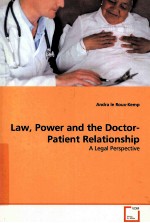图书介绍
LAWPDF|Epub|txt|kindle电子书版本网盘下载

- POWER AND THE DOCTOR-PATIENT RELATIONSHIP A LEGAL PERSPECTIVE 著
- 出版社: VDM VERLAG DR.MULLER
- ISBN:3639341376
- 出版时间:2011
- 标注页数:282页
- 文件大小:12MB
- 文件页数:293页
- 主题词:
PDF下载
下载说明
LAWPDF格式电子书版下载
下载的文件为RAR压缩包。需要使用解压软件进行解压得到PDF格式图书。建议使用BT下载工具Free Download Manager进行下载,简称FDM(免费,没有广告,支持多平台)。本站资源全部打包为BT种子。所以需要使用专业的BT下载软件进行下载。如BitComet qBittorrent uTorrent等BT下载工具。迅雷目前由于本站不是热门资源。不推荐使用!后期资源热门了。安装了迅雷也可以迅雷进行下载!
(文件页数 要大于 标注页数,上中下等多册电子书除外)
注意:本站所有压缩包均有解压码: 点击下载压缩包解压工具
图书目录
Chapter 1: Introduction1
1.1.Background1
1.2.Identifying the doctor and the patient in health service delivery5
1.3.When does a doctor-patient relationship come into being?9
1.4.Aim and methodology13
1.5.Research question and underlying assumptions16
1.6.Outline of study17
1.6.1.Chapter 217
1.6.2.Chapter 317
1.6.3.Chapter 418
1.6.4.Chapter 519
1.6.5.Chapter 619
1.6.6.Chapter 720
1.6.7.Chapter 820
PART A22
Chapter 2: The historical development of the doctor-patient relationship and the culture of medical care22
2.1.The historical development of the doctor-patient relationship23
2.1.1.Primitive society25
2.1.2.The Greek medical tradition (± 600- 100 B.C.)27
2.1.3.Classical, medieval and early modern societies (1200-1600A.D.)29
2.1.4.Modern western societies (1700-1900A.D.)31
2.1.5.Postmodern societies32
2.2.The culture of medical care34
2.2.1.Professionalism and the regulation of the medical profession34
2.2.2.Social roles and the doctor-patient relationship41
2.2.2.1.The physi?an’s role42
2.2.2.2.The sick role44
2.2.3.Professionalism, authority and the doctor-patient relationship45
2.2.4.Power and the doctor-patient relationship52
2.3.Conclusion56
Chapter 3: Medical decision-making and the doctor-patient relationship in a paternalistic setting58
3.1.Defining medical paternalism59
3.2.Medical decision-making in a paternalistic medical setting65
3.3.Autonomy, dignity, self-determination and beneficence in medical decision-making71
3.4.Ajuridical response to traditional paternalism in medical decision-making79
3.4.1.Informed consent81
3.4.1.1.The origin of informed consent82
3.4.1.2.The development of the doctrine of informed consent88
3.4.1.3.The current status of the doctrine of informed consent94
3.5.An evaluation of medical decision-making and the doctor-patient relationship103
3.5.1.Standards of disclosure105
3.5.2.Historical attributes111
3.5.3.Practical considerations112
3.5.4.The efficiency of the doctrine of informed consent115
3.5.5.Recommendations117
3.6.Conclusion122
PART B125
Chapter 4:The doctor-patient relationship in the medical marketplace125
4.1.Definingthe business model in medical practice126
4.2.The relevanoe of the business model to medical practice and the doctor-patient relationship132
4.3.The business model and the power imbalances in the doctor-patient relationship139
4.3.1.Informed consent139
4.3.2.Patients’ rights, patient autonomy and the defiance of benefioence146
4.3.3.The erosion of trust in the doctor-patient relationship150
4.4.Conclusion155
Chapter5: The fiduciary nature of the doctor-patient relationship158
5.1.The doctor-patient relationship as a fiduciary relationship159
5.2.The legal content of the fiduciary relationship between doctor and patient167
5.3.The doctor as a fiduciary in the doctor-patient relationship171
5.3.1.The duty of loyalty172
5.3.2.The duty to act in the patient’s best interest175
5.4.The patient as a beneficiary in the doctor-patient relationship178
5.4.1.Right ore ntitlement to a benefit enforceable against the fiduciary178
5.5.An evaluation of the doctor-patient relationship as a fiduciary lationship182
5.6.Conclusion188
PART C191
Chapter 6: The doctor-patient relationship in an era of managed care191
6.1.The history and development of managed care in health service delivery193
6.2.The influence of managed care practices on the doctor-patient relationship201
6.2.1.Access to health care204
6.2.2.The new role of the physician in the doctor-patient relationship210
6.2.3.Trust in the doctor-patient relationship and trust in managed care institutions212
6.2.4.Informed consent in an era of managed care217
6.2.5.Patient advocacy in an era of managed care222
6.3.Conclusion224
Chapter 7: Consumerism and the doctor-patient relationship227
7.1.Consumer choice, patient autonomy and the ethical limits of consumer responsibility231
7.2.Consumer protection in the doctor-patient relationship235
7.3.Consumer empowerment and the doctor-patient relationship240
7.4.Conclusion242
Chapter 8: A proposed re-conceptualisation of the doctor-patient relationship to redress power imbalances245
8.1.Are there power imbalances in the doctor-patient relationship?246
8.2.Can the doctor-patient relationship be re-conceptualised, from a legal perspective, to redress the power imbalances inherent in the relationship?250
8.2.1.The role of autonomy, dignity, self-determination and benefioence in the doctor-patient relationship250
8.2.2.The doctrine of informed consent and the power imbalances in the doctor-patient relationship252
8.2.3.The fiduciary nature of the doctor-patient relationship and the power imbalances inherent in the relationship253
8.2.4.The role of trust in the doctor-patient relationship255
8.3.Concluding remarks258
Table of cases260
Bibliography264
Index280